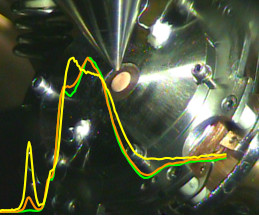The nature of nitrate at the ice surface
Surface Chemistry Research Group, Head Markus Ammann.
Trace contaminants such as strong acids have been suggested to affect the thickness of the quasi-liquid layer at the ice/air interface, which is at the heart of heterogeneous chemical reactions between snowpacks or cirrus clouds and the surrounding air. We used X-ray photoelectron spectroscopy (XPS) and electron yield near edge X-ray absorption fine structure (NEXAFS) spectroscopy at the Advanced Light Source (ALS) to probe the ice surface in the presence of HNO3 at 230 K. We studied the nature of the adsorbed species at the ice/vapor interfaces as well as the effect of HNO3 on the hydrogen bonding environment at the ice surface. The NEXAFS spectrum of ice with adsorbed HNO3 can be represented as linear combination of the clean ice and nitrate solution spectrum, thus indicating that in the presence of HNO3 the ice surface consists of a mixture of clean ice and nitrate ions that are coordinated as in a concentrated solution at the same temperature but higher HNO3 pressures.
